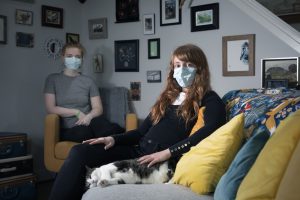As seven states now require masks and face coverings for visiting essential businesses or using public transportation, it seems like those spaces are where we are most at risk for COVID-19 infection. But, in truth, the riskiest place could be our homes — at least, if you live with someone who tests positive for the virus. That’s why Jessica Lin, an infectious disease researcher at the University of North Carolina at Chapel Hill, is leading a study to address the infection rates of household members living with someone who has tested positive for COVID-19.
The study solicits participants via UNC Hospital’s drive-through testing center. Lin’s team will make a home visit the day after diagnosis to collect an additional nose swab specimen from the COVID-19-positive person, along with specimens from their consenting household members. They will do this once a week for three weeks and will then collect a blood sample to understand infection rates. Lin hopes to enroll at least 100 participants.

“If you want to understand community transmission, this is the place to start,” Lin says. “It’s also a good setting for understanding more about pre-symptomatic and asymptomatic transmission. It will give us an idea of the ring of people surrounding one person’s diagnosis.”
Data from previous studies suggest a wide range of possible rates of household transmission — anywhere from 5 to 30 percent, Lin says. She predicts to see lower rates in Chapel Hill, where the population is more affluent and has the means to self-quarantine. She also believes there will be substantial spread of the virus within the household by the time the first person is diagnosed with COVID-19.
This will also expose inherent challenges within communities, according to Lin.
“For example, we know at this point that a lot of people diagnosed in Chapel Hill are connected to several of the nursing homes,” Lin says. “We might find that’s where most of our affected population is.”
It will take time to analyze the results from this study, Lin says. She and her team are currently focused on modifying their lab to handle infectious samples, which includes developing decontamination protocols and setting up testing procedures for the blood samples.
Lin is collaborating with Kimberly Powers, a public health researcher in the UNC Gillings Schools of Global Public Health, to use data from this study to develop a model for how COVID-19 transmission in households impacts the epidemic. This data could also help public health departments develop protocols for people who receive a positive diagnosis and guide the nation’s leaders as they decide how and when to lift stay-at-home orders.
Like most COVID-19-related projects on campus, Lin’s is an all-hands-on-deck situation. She’s working alongside UNC physicians David Wohl and Carla Cerami to implement the field study, as well as Jonathan Juliano, who is overseeing the laboratory analysis, and Premkumar Laksmanane, a UNC virologist developing the serologic blood test for the study.
“It’s been really intense,” Lin says. “This kind of study takes about six months to get off the ground — and we’re trying to do it in three to four weeks. So everybody’s working on hyperdrive. But I am proud to see everyone in the infectious disease division step up to make contributions in all realms, from patient care to hospital preparedness to research.”
Jessica Lin is an assistant professor in the Department of Medicine’s Division of Infectious Diseases within the UNC School of Medicine and a clinician for UNC Health.